
UNAIDS Executive Director Mr Michel Sidibé, 21 September, 2010. Credit: UNAIDS/Hamilton
There is now global recognition that one Millennium Development Goal cannot be achieved without the others. The health sector, in particular, has realized that responses to Millennium Development Goals 4, 5 and 6—to reduce child mortality, improve maternal health, and combat HIV malaria and other diseases—must be tackled together to improve people’s life.
At a side event of the UN Millennium Development Goals Review Summit taking place from 20 to 22 September in New York, Botswana shared its experiences in integrating health interventions and programmes in order to maximize resources and improve health outcomes.
Botswana, a country with an HIV prevalence of 23.9% in its adult population, has recently made progress in curbing the epidemic. Data shows that HIV prevalence among young people aged 15-24 years has been declining consistently since 2001. The country has also managed to tackle child mortality through expanded feeding programs for children under five together with near universal coverage of services to prevent mother-to-child transmission of HIV.
At the event, entitled “Toward an Integrated approach to Attaining Health Related Millennium Development Goals,” Mr Mompati S. Merafhe Vice President of Botswana, presented the country’s case to show what integrating health services means in practice.
According to Vice President Merafhe, Botswana was able to mount a credible response to AIDS, and strengthen health systems through an integrated approach. He stressed the importance of partnerships, including that of the United Nations.
“We have crated an enabling environment and we have closed gaps that take us on the road to reach the MDGs by 2015,” said Vice President Merafhe. “This has resulted in our success in preventing mother-to-child transmission of HIV.”
Research shows that countries with the highest incidence of HIV often have a high unmet need for family planning. Offering HIV services and contraceptives at the same facility, or even by the same health care worker, increases the opportunity to access services.

Mr Mompati S. Merafhe Vice President of Botswana, 21 September, 2010. Credit: UNAIDS/Hamilton
According to the panellist, the benefits of integrating services are many: combining interventions at point-of-care, as well as sharing a supply chain, and information systems are all examples of how resources can maximized. Importantly, they stressed the process also decreases out-of-pocket costs for the individual, through reducing the number of visits to health centres, thus minimizing travel time and cost, as well as fees associated with accessing services.
“As has been shown by Botswana’s leadership, the AIDS response can be the bridge that connects movements,” said Michel Sidibé, UNAIDS Executive Director. “Programmes advancing maternal and child health, sexual and reproductive health, gender equality, sexual violence all contribute to achieving the MDGs.”
To assess the way forward the session included a range of topics on health service integration. Mr Erik Solheim, Minister of Environment and International Development of Norway gave the donors perspective. UNAIDS, UNICEF and UNFPA discussed the benefits of integration from the bilateral outlook. The Elizabeth Glaser Paediatric AIDS Foundation (EGPAF) gave further insights from the implanting organizations point-of-view.
While there are many benefits of integrating health services, integration is not a “one-size-fits-all” strategy, according to the participants. For example, countries with a weak health system, integrating services may overburden an already stretched system. The process of planning and implementing integrated services also poses a number of technical challenges for governments, policy donors, program implementers, and health care workers.





